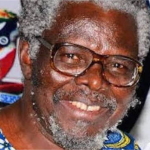Re/Views & Critique
Re-reading The Man Died
A review of (or essay about)
culled from GUARDIAN, November 18, 2004
One of the many and essays written in commemoration of Wole Soyinka’s 70th birthday a couple of months ago was a review of The man died, the prison notes published by the famous writer in 1972. Well, the essay in question was not exactly a review; it was more of a review of reactions to the appearance of The man died. The reviewer remembered that I was critical of the book, considering it “non-ideological”. I stretched my memory to recall when exactly I said so, and in what context. My conclusion was that I must have made the remark in mid-1975 shortly after I was released from detention to which I was sent by the same military junta which had incarcerated Soyinka for almost the entire duration of the Nigerian Civil War (July 1967-January 1970). I could not recall the context. However, instead of responding to a review of reviews, I decided on a more useful response: looking at the book once again.
I am acutely aware of the unflattering remarks Soyinka was said to have made about Marxists, Communists and Socialists. In fact some people often tease me with this. No comments, except to say that Soyinka appears to have problems with “barracks” socialism, just as I had, and still have. The only difference is that I am attacking “barracks” socialism from a position different from that of Soyinka.
The man died, written by a young man who, even at that time, had become a celebrated writer and social activist, was regarded a subversive publication by Gowon’s military junta. The first copy I read was literally smuggled into the country without covers. It was passed from hand to hand at the University of Lagos where I was a graduate student. That was a long time ago. We now have two copies of the book: one, hard-cover, published by Rex Collings in 1972; and the other, paper-back, published by Penguin Books in 1975. I have not been able to see the newest edition published about a decade ago. The two copies we have shown signs of “heavy” reading by my spouse and me. The areas we marked show that while my spouse was angry at the crudity of Soyinka’s interrogators, I was more furious with the military junta and the politicians and intellectuals who voluntarily supported, inspired and encouraged the murderous gang.
Except for two brief entries, which are in Rex Collings edition, but missing in the Penguin edition, the two copies I have with me have the same content. The “omissions” are important historically. The first one is titled Tailpiece, and it appears between the last page of the main text and the Appendices. It is a report of a brief encounter between the military head of State, General Yakubu Gown and Bola Ige at Ibadan shortly after the end of the war. The latter was then a Commissioner in the government of Western State. “How is your friend?”, Gowon asked Ige. The latter replied: “Who?” Gowon: “Wole. How is he?”. Ige replied that Soyinka was “alright”, whereupon Gowon sent this message: “Tell him I said, Bygones is bygones. Right? Use my exact words – Bygone is bygones”. This dialogue took place not later than 1972, that is, 32 years ago.
In the second omission, a postscript, titled Appendix C (suspended) Soyinka tells the readers that the last section of the book had been removed. This he did, so as not to further inflame passions – as he was convinced that “it will take a long time, possibly generations before passions completely die out over the Nigerian Civil War”. Soyinka cited a post-war publication, “Nigeria – A decade of crises in pictures”, to show that passions were still high as late as 1972, the third year of reconciliation. The removed entry contained “checked and verified details of the activities of federal troops in the Mid-West after victory”. The activities were “systematic executions”.
Having sorted out the omissions, my references from now are to the Rex Collings Edition. The man died is divided into three main parts: Part I: Ibadan -Lagos (sections 2-15); Part II Kaduna, 1968: (sections 16-28); and Part III Kaduna, 1969: (sections 29-41). In addition to these the book contains: an acknowledgement titled “the unacknowledged”, A letter to compatriots which takes up section I; Appendices and a dedication to “Laide, who rejected compromise and demanded justice”. The 105,000 – word book covers 320 pages.
Soyinka divided his book into three parts ” according to space and time. Thematically, however, the content of The man died can be distilled into at least four separate, but connected parts. My understanding of the loaded book was enhanced by this separation. The first is an account of Wole Soyinka’s arrest, detention, interrogation, attempt to frame and, perhaps, liquidate him while in detention, his experiences and, of course, his survival. The second is a story of the Nigerian crisis from the assumption of office by General Aguiyi-Ironsi in January 1966 to Soyinka’s arrest in September 1967; and what Soyinka and some other radical intellectuals and Nigerian patriots did to end the crisis and prevent a civil war and, once the war had started, to end it. The third part is a radical denunciation, with documentary substantiation, of the military dictatorship and its “Gestapo” methods which he regarded as fascist: a fascist dictatorship which continued after the civil war.
The fourth part is a moving reflection on power: what happens when it is corrupted and the continuous struggle between power and its victims. Here Soyinka awarded himself considerable literary licence – in terms of language, style and references. The four themes, as I said, are interwoven. If, for any reason, you want to understand this book, then you have to read it at least twice: the first time to appreciate its general flow and range and the second time, to understand the various themes. If you do this – bearing in mind that you study Soyinka, not just read him ” you are likely to see the book as an intellectual treasure; otherwise, you may end up complaining, like many of us do, that Soyinka is “too difficult”.
Every appreciation of the book, The man died, however short, must include an account of how this title came about, and other decisions accompanying the choice of title. Until the very last moment the title was to be A Slow Lynching. Then Soyinka received a cable with the single message The man died. Behind the message is the tribulation of a practicing Nigerian journalist who was a victim of a military governor’s sadistic abuse of power. The journalist had been sent, along with his colleagues, to cover a party which the governor and his wife attended. The press was invited by the organiser and host of the party; and the journalist was officially assigned to join the press crew. However, the governor’s wife complained about the “rudeness” of the journalists; whereupon, on the governor’s orders, the journalists were rounded up, detained, shaved, brutally beaten and then dismissed from their jobs. The condition of one of the victims became so bad that he was taken abroad and amputated. He lost a three-year battle for his life. He was flown back to Nigeria where he died within six weeks.
On receiving this message, Soyinka decided not only to change the title of his book to The man died, but to overcome his hesitations concerning what to include in the book, what to exclude and when to publish it. He said: “I recognised also that I moved long ago beyond compromise, that this book is now, and that only such things should be left out which might imperil those on whom the true revolution within the country depends…” Soyinka used the words “revolution” and “comrade” in a genuine and convincing manner. I acknowledge that these words are not exclusive to the Marxist political lexicon. Soyinka appeared in this book as a revolutionary democrat. It is sad for me comparing his activities during the crisis with what the majority of Nigerian Marxists and communists were doing: Literally running errands for Gowon and Ojukwu. Did Soyinka ever encounter P.A. Curtis-Joseph, one of the few Nigerian leftists who took a similar stand: opposition to genocide, opposition to secession and opposition to war.
Though a story of a tragedy, The man died is not uniformly “dry” and “hard-hitting”. There are moments when you find yourself laughing: situations that can be described in Yoruba with the phrase “oro buruku pelu erin” ” laughing over a tragic story. Soyinka’s encounters with prison warders and superintendents account for most of the laughing moments. I laugh any time I recall the address to detainees in Kirikiri Prison, Lagos, delivered by a prison governor early in Soyinka’s long detention. It is the worst assault on English Language I have ever read. The comedian, Zebrudaya, must have studied English under the prison governor. It was from governor that I learnt that the correct name for an enemy of the state is “sabotagist”, and not “saboteur”; and that a dead person could be summoned to serve as witness. I was also embarrassed to hear myself laughing while reading a lecture on execution (by hanging) delivered to Soyinka by a prison warder in Kaduna Prison.
About the Author

